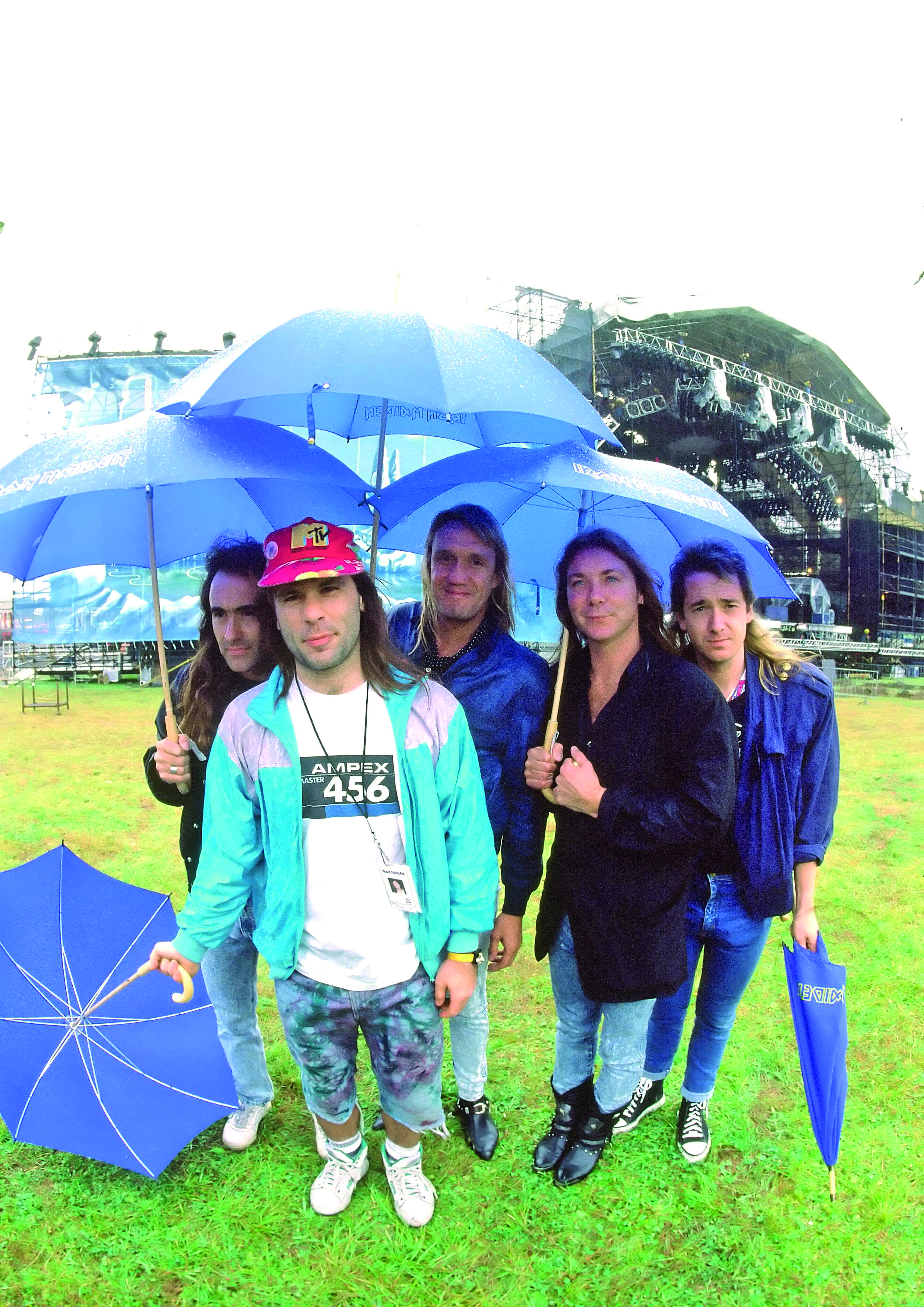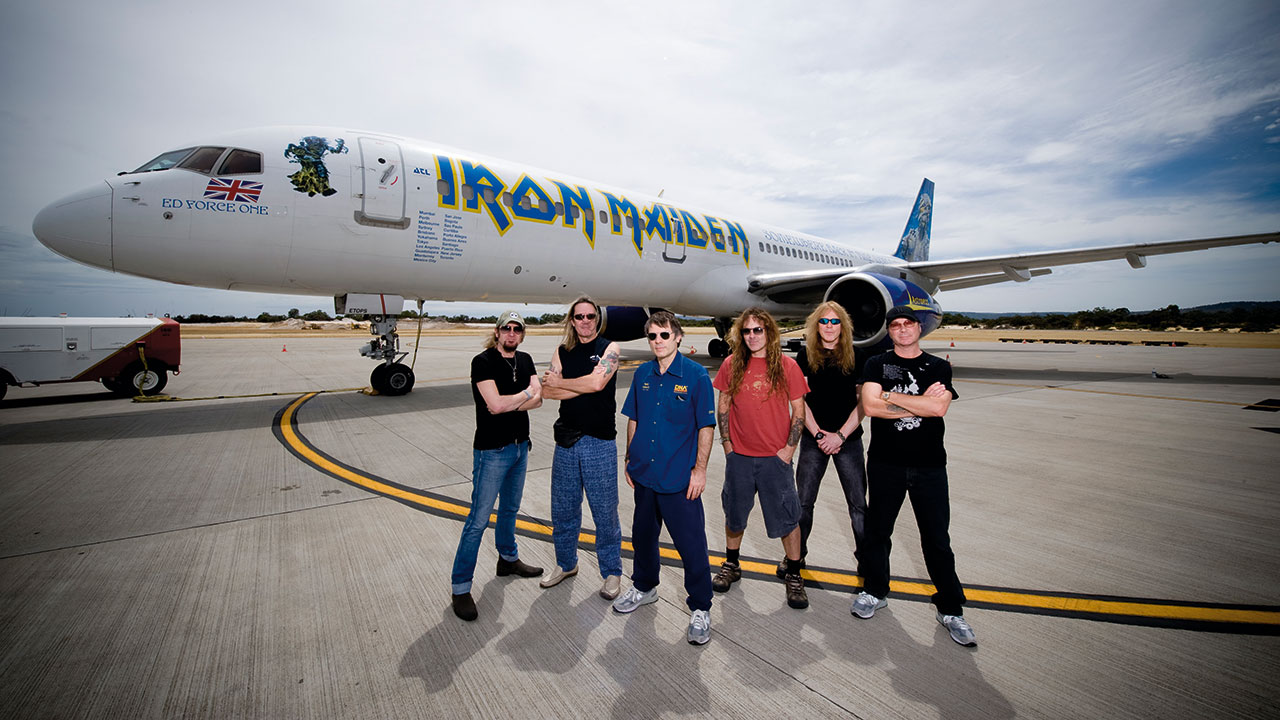The world is a vastly different place from the one that birthed the first issue of Metal Hammer in 1986. One thing, however, remains constant, reliable and perennially reassuring: Iron Maiden. It hardly needs explaining why they have graced our cover so many times over the last three decades (20 and counting!), but it’s still hard not to marvel at this band’s unwavering ability to remain at the top of their game. Somehow, Iron Maiden are even bigger around the world in 2016 than they were when we first sang their praises in the midst of their mid-80s glory days. And there is clearly plenty of life in the old dogs yet, too…
“Alright, don’t rub it in!” Steve Harris laughs. “Thirty years… it’s scary, isn’t it? Where has the time gone?”
Rewind to 1986, and Iron Maiden were very much at the peak of their powers, and steadily approaching the apex of their first wave of popularity. Having played in front of roughly three-and-a-half million people during the World Slavery Tour that concluded the previous summer, the band were up against it when it came to making a new album and topping their recent triumphs. Fortunately, their next album was the magnificent, sci-fi-tinged Somewhere In Time: both Maiden’s most adventurous album to date and the perfect starting point for the next extravagant stage set. The tour, inevitably titled Somewhere On Tour, kicked off in Belgrade in September 1986, two full weeks before the album’s release, and its eye-frazzling, futuristic imagery and giant cyborg Eddie proved to be an immediate hit with Maiden’s rapidly expanding global audience.
“What I remember most about the Somewhere In Time tour was having an argument with Rod [Smallwood, Maiden’s manager]. I wanted to film the tour and he wasn’t having any of it,” Steve grumbles. “I said, ‘We’ve got to film the tour!’ but he wasn’t into it. [impersonating Rod] ‘Noooo, we don’t need to film the bloody tour!’ Of course, later on he ended up saying, ‘Oh, I wish we’d filmed the tour…’, ha ha! But it was a great-looking tour. It looked fantastic, but we’ve got hardly any footage of it anywhere. We filmed the video for Stranger In A Strange Land at Sheffield City Hall, but apart from that we haven’t got much at all. But what can you do? I rest my case, Rod, ha ha ha!”

Given how unstoppable Iron Maiden have been in recent times, it would be easy to think that the last 30 years have been a smooth ride. But as older fans will doubtless remember, the band’s second full decade was considerably less triumphant than their first. 1988’s Seventh Son Of A Seventh Son took Maiden ever further up charts worldwide, but as the 90s dawned it steadily became apparent that traditional metal was under siege from new ideas and changing tastes. With hindsight, it probably didn’t help that after the departure of Adrian Smith in 1990, Maiden followed Seventh Son… with the patchy, back-to-basics No Prayer For The Dying. But irrespective of the music they were making, Maiden were heading for choppy waters as the fledgling vultures of grunge and nu metal circled above.
“It was just one of those times when anything that suggested ‘heavy metal’ was a bit of a no-no,” Steve recalls today. “That was the perception anyway, but it wasn’t really like that. We held our heads above water perfectly well, as did most metal bands. The perception was that metal wasn’t going to be around for too much longer, but of course, as we know, that didn’t prove to be the case! It was a very odd time.”
The departure of talismanic frontman Bruce Dickinson in 1993 made the situation even odder. In fact, his decision to pursue a solo career momentarily pulled the rug from under the British legends’ feet. Being Iron Maiden, they ploughed gamely forward, of course, enlisting ex-Wolfsbane frontman Blaze Bayley along the way and continuing to tour extensively to crowds that most bands would cheerfully kill to attract. But as Steve admits, the 90s were undoubtedly the darkest time in Maiden’s illustrious history.
- I Went Behind The Iron Curtain With Iron Maiden
- The Top 10 Best Iron Maiden Videos
- The 12 best Iron Maiden memes
- Every Iron Maiden Album Ranked From Worst To Best
“Yeah, it was a tough time. Back then almost everyone was going through squeaky bum time, weren’t they?” he laughs. “It was obvious something was amiss, but we all just kept going, even when the whole metal scene was weak at the knees. Magazines were even taking the word ‘metal’ out of their names! And then when Bruce left, I’d just been through a divorce, which was tough, and suddenly we were struggling a bit. The others were looking to me for some strength but I was probably at my lowest ebb at that point. But you brush yourself down, pick yourself up and get back on with it. It was a real challenge, and I love challenges.”
There’s no great secret to Maiden’s more-or-less inarguable status as the world’s best-loved metal band: they simply refuse to let anyone down, and everyone that gives a shit about them instinctively knows that their support is appreciated and valued. As ever, Steve is quick to attribute Maiden’s success and longevity to the fans’ loyalty, particularly as they traversed the turbulent terrain of the 90s together.
“The hardcore Maiden fans, and they know who they are, they were fantastic back then,” says Steve. “They were willing the band not to go under… not that there was ever any chance of that. We were still playing to a lot of people, it was just 8,000 a night instead of 12,000, and that’s still OK, isn’t it? We lost a lot of ground but we still did incredibly well. The fans were so hardcore that some of the reactions were even more enthusiastic than usual. You go through a tough time like that and it was weirdly enjoyable, in a masochistic sort of way!”
Many bands have split up or fallen by the wayside over the last 30 years. Most of them have probably reformed at some point, but Maiden never needed to pursue the nostalgia circuit because they never stopped motoring along. Suggest to Steve Harris that he may have contemplated knocking the whole thing on the head when Maiden were suddenly swimming against the musical tide, and his response is immediate and definitive.
“No, never. We never contemplated stopping at all. When Bruce left, it was all a bit of a blow, but I remember sulking for two hours and then thinking, ‘Right, fuck this!’ I say that to my kids now: you can sulk for two hours and then get on with it! It wasn’t easy but life never is. In a career as long as ours, you’re gonna have ups and downs. I’m sure it’s the same for a magazine like Metal Hammer, too. You just have to weather the storm. And we all did!”

There’s weathering the storm and then there’s coming back at full strength, with full force, and smashing a remorseless succession of home runs. That is effectively how Maiden’s last 16 years have panned out. In terms of musical masterstrokes, the decision to reunite with Bruce Dickinson and guitarist Adrian Smith has to rate as one of the most brilliant and, subsequently, fruitful of all time.
“I knew it would work musically. It worked before, so why wouldn’t it work?” says Steve. “It’s well documented that I thought that they had to be sure that they were coming back for the right reasons, and they were. That was the key thing for me. It’s been much better since. Everyone’s grown up and it’s been a lot more fun. In a weird sort of way, being apart for that period of time was probably best for everybody in the end. They both went away and got something out of their systems, which they obviously needed to do, and then they came back and realised that they probably enjoyed it more than they thought they did! It’s all worked out great.”
Even those who don’t like Iron Maiden much must surely admit that they have long since mastered the knack of keeping the faithful happy. Over the last 16 years, they have not only released a series of widely acclaimed albums, but also put on epic tour after epic tour (with plenty of barnstorming festival headlining sets thrown in for good measure). Maiden have evolved, too, becoming more progressive in their approach and seeming even less interested in following current trends in the process. Thirty years into the Metal Hammer story, Iron Maiden’s story is as riotously entertaining and musically enthralling as it ever was, and Steve Harris is a long, long way from losing his enthusiasm for writing new chapters.
“Well done to anyone who’s lasted this long, whether it’s Metal Hammer or Iron Maiden or whoever!” he chuckles. “Personally I’m enjoying it more than ever, I’d say. I think we all are. Since we had that scare with Bruce’s health, everything has been even more enjoyable. Ultimately, at this point you know you’ve had most of your career and there’s less ahead than there is behind you, but we’ll definitely make more albums and we’re having a great time. This is still the best job in the world.”
The Totally Impossible Iron Maiden Quiz
The Top 10 most underrated Iron Maiden songs
From obscurity to Iron Maiden (and back again): an epic Blaze Bayley interview

